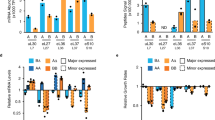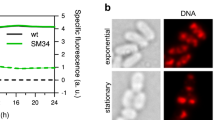Abstract
IN bacteria there is a coordinate regulation of the synthesis of ribosomal RNA and ribosomal protein1. This is most evident from studies of the rates of synthesis of ribosomal components as a function of the growth rate of the cell2,3. Another example is the ‘stringent response’, in which cells deprived of an essential amino acid shut down the transcription of ribosomal RNA as well as that of messenger RNA for ribosomal proteins4,5, but increase the synthesis of mRNA for certain biosynthetic proteins6. Although this stringent response is at least partially due to the rc gene product and/or its synthesis of ppGpp, little is known about the detailed mechanisms involved in controlling the two types of transcription. To what degree does the stringent response exist in eukaryotic cells, which use separate polymerases for the transcription of ribosomal RNA and messenger RNA6? We7 and others8 have shown that in Saccharomyces cerevisiae deprived of an amino acid, the transcription of ribosomal RNA is severely inhibited. Ribosomal RNA transcription is also inhibited in cells treated with cycloheximide7,9, but it continues almost normally in cells in which synthesis of ribosomal proteins has specifically been inhibited through a temperature-sensitive mutation10. We demonstrate here that in cells deprived of an amino acid there is a specific depletion of messenger RNA coding for ribosomal proteins.
This is a preview of subscription content, access via your institution
Access options
Subscribe to this journal
Receive 51 print issues and online access
$199.00 per year
only $3.90 per issue
Buy this article
- Purchase on Springer Link
- Instant access to full article PDF
Prices may be subject to local taxes which are calculated during checkout
Similar content being viewed by others
References
Nomura, M., Morgan, E. A. & Jaskunas, S. R. A. Rev. Genet. 11, 297–347 (1977).
Dennis, P. J. molec. Biol. 88, 25–41 (1974).
Gausing, K. J. molec. Biol. 115, 335–354 (1977).
Dennis, P. J. Bact. 129, 580–588 (1977).
Stephens, J., Artz, S. & Ames, B. Proc. natn. Acad. Sci. U.S.A. 72, 4389–4393 (1975).
Hager, G., Holland, M., Valenzuela, P., Weinberg, F. & Rutter, W. J. in RNA Polymerase (eds Losick and Chamberlain) 745–762 (Cold Spring Harbor Laboratory, New York, 1976).
Shulman, R. W., Sripati, C. E. & Warner, J. R. J. biol. Chem. 252, 1344–1349 (1977).
Gross, K. J. & Pogo, A. O. J. biol. Chem. 249, 568–576 (1974).
deKloet, S. R. Biochem. J. 99, 566–581 (1966).
Shulman, R. W. & Warner, J. R. Molec. gen. Genet. 161, 221–223 (1978).
Warner, J. R. & Gorenstein, C. Cell 11, 201–212 (1977).
Sripati, C. E. & Warner, J. R. Meth. Cell Biol. 20, 61–81 (1978).
Cooper, T. G., Marcelli, G. & Sumrada, P. Biochim. biophys. Acta 517, 464–472 (1978).
Laemmli, U. K. Nature 227, 680–682 (1970).
Gorenstein, C. & Warner, J. R. Proc. natn. Acad. Sci. U.S.A. 73, 1547–1551 (1976).
Author information
Authors and Affiliations
Rights and permissions
About this article
Cite this article
WARNER, J., GORENSTEIN, C. Yeast has a true stringent response. Nature 275, 338–339 (1978). https://doi.org/10.1038/275338a0
Received:
Accepted:
Issue Date:
DOI: https://doi.org/10.1038/275338a0
This article is cited by
-
Isolation and characterization of mutants defective in production of laccase in Neurospora crassa
Molecular and General Genetics MGG (1993)
-
Transcription of the yeast mitochondrial genome requires cyclic AMP
Molecular and General Genetics MGG (1993)
-
rna12 +, a gene of Saccharomyces cerevisiae involved in pre-rRNA maturation. Characterization of a temperature-sensitive mutant, cloning and sequencing of the gene
Molecular and General Genetics MGG (1992)
-
Regulation of mitochondrial transcription during the stringent response in yeast
Current Genetics (1992)
-
Changes in gene expression elicited by amino acid limitation in Neurospora crassa strains having normal or mutant cross-pathway amino acid control
Molecular and General Genetics MGG (1985)
Comments
By submitting a comment you agree to abide by our Terms and Community Guidelines. If you find something abusive or that does not comply with our terms or guidelines please flag it as inappropriate.



